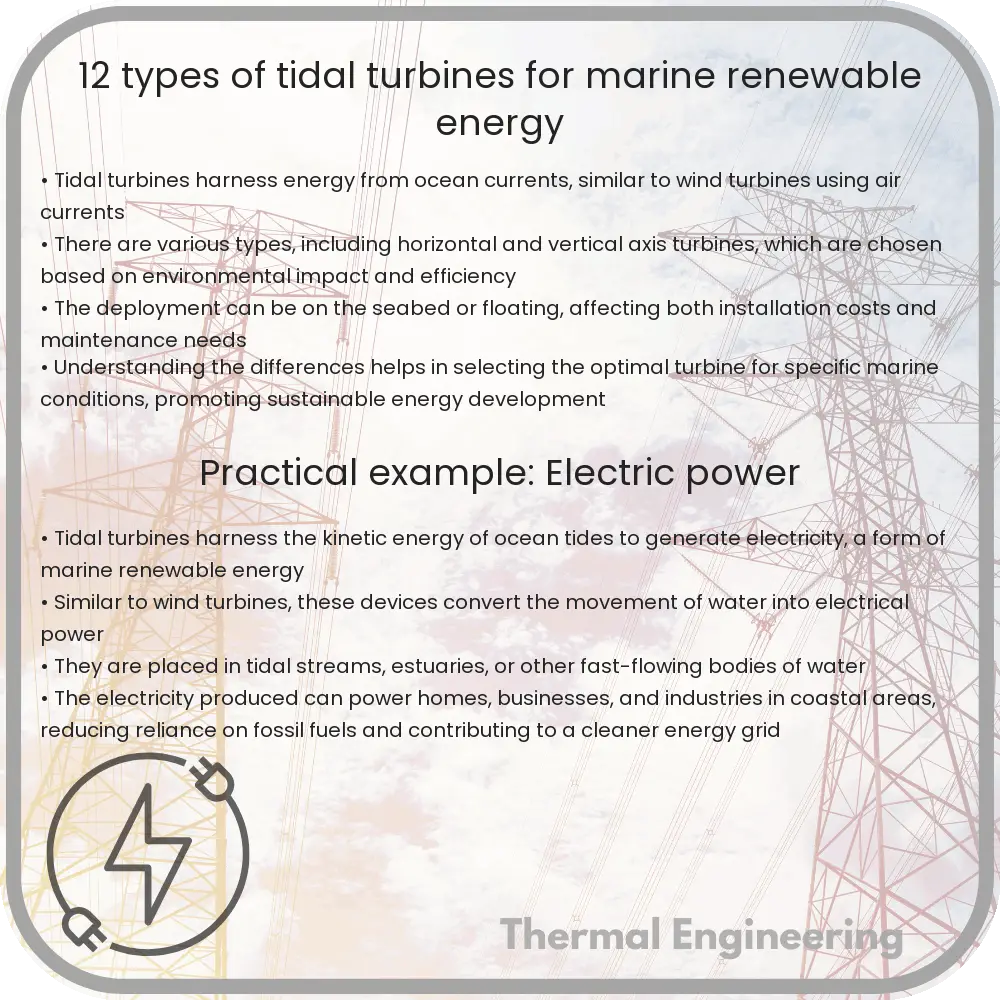Understanding the diverse types and functionalities of tidal turbines in marine renewable energy.

12 Types of Tidal Turbines for Marine Renewable Energy
Tidal turbines are essential components in the field of marine renewable energy, harnessing the energy from tidal flows to generate electricity. Similar in concept to wind turbines, these structures are submerged in water and capture kinetic energy from moving masses of water. Here we explore twelve different types of tidal turbines and their unique characteristics.
1. Horizontal Axis Tidal Turbines
These turbines resemble traditional wind turbines and are the most common type used in tidal energy conversion. They usually feature two or three blades rotating around a horizontal axis.
2. Vertical Axis Tidal Turbines
Vertical axis turbines have the main rotor shaft arranged vertically, an advantage in tidal environments as they can catch the tide from any direction. This type includes the Darrieus and Savonius models, named after their inventors.
3. Ducted Turbines
Ducted turbines feature a shroud or duct surrounding the blades, which helps to increase the velocity of the water flow, thereby enhancing efficiency.
4. Open Hydro Turbines
Designed with an open-center allowing water to flow through the core of the turbine, Open Hydro turbines minimize marine life disruption and are marked by their ring-shaped design.
5. Tidal Kites
Tidal kites are a novel type of underwater turbine that is tethered to the ocean floor and flies through the water in a figure-eight pattern, capturing energy through a turbine in the kite itself.
6. Oscillating Hydrofoil Turbines
This type of turbine utilizes a wing that oscillates in the tidal or ocean current, driving a mechanical system to generate electricity.
7. Archimedes Screw Turbines
Inspired by the ancient Archimedes Screw pump, these turbines consist of a helical screw blade that rotates with the flow of the tide to generate power.
8. Cross Flow Turbines
Also known as orthogonal or transverse turbines, these have a cylindrical rotor with blades rotating perpendicular to the flow of water, featuring a simpler and more robust design suitable for marine conditions.
9. Pontoon-mounted Turbines
These turbines are mounted on floating platforms (pontoons), making them easy to install and remove, and suitable for areas with fluctuating water levels.
10. Subsea Turbines
Located on the seabed, subsea turbines can be beneficial in deep water settings, although they require complicated maintenance and installation procedures.
11. Modular Turbine Arrays
These arrays involve multiple turbines linked together to form a modular unit, optimizing the footprint and energy capture of tidal streams.
12. Gravity-based Structure Turbines
Gravity-based turbines sit on the seabed without the need for drilling, minimizing environmental impact and simplifying installation.
The choice of tidal turbine depends on numerous factors, including water depth, flow velocity, environmental impact, and economic considerations. Ongoing research and development are enhancing the efficiency and viability of these turbines, paving the way for their broader adoption in the quest for renewable energy solutions.
Conclusion
Tidal turbines stand at the forefront of marine renewable energy technology, providing an eco-friendly and efficient method to harness energy from tidal currents. With diverse types of turbines evolving, each adapted to particular marine environments, the potential for expanding this energy source is tremendous. As technology advances, the integration of tidal energy into our energy grid promises a more sustainable and resilient energy future.